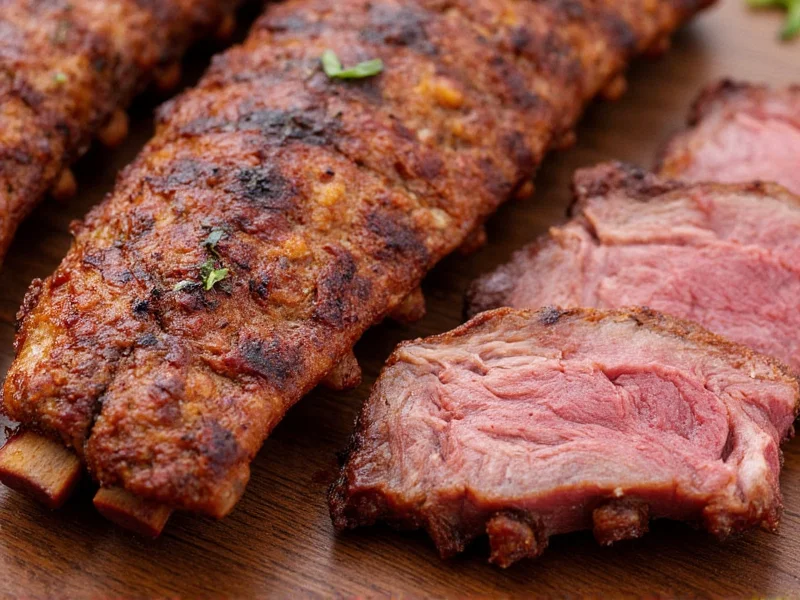Understanding the differences between pork rib cuts is essential for achieving perfect results whether you're grilling, smoking, or oven-roasting. Many home cooks and barbecue enthusiasts struggle to choose between back ribs and spare ribs, often ending up with disappointing results when they apply the wrong cooking technique to the wrong cut.
What Exactly Are Back Ribs?
Back ribs, commonly marketed as baby back ribs, are harvested from where the rib bones connect to the spine, right below the loin muscle. Despite the "baby" moniker, these ribs don't come from young pigs but earned their name due to their smaller size compared to other cuts. A typical rack of back ribs measures 3-6 inches wide and contains 10-13 curved bones.
These ribs feature less marbling and fat than spare ribs, with meat located primarily between the bones rather than on top. The leaner composition makes back ribs more tender with a milder pork flavor. Because they're taken from a less exercised part of the pig, they cook relatively quickly—usually 2-3 hours at 225-250°F.
Understanding Spare Ribs
Spare ribs come from the lower belly area of the pig, extending from the breastbone to the shoulder blade. This cut includes 11-13 flatter, straighter bones with significantly more fat and connective tissue. A full rack of spare ribs typically weighs 3-4 pounds and measures 6-8 inches wide.
The higher fat content in spare ribs delivers richer flavor but requires proper rendering to achieve tenderness. Many butchers offer St. Louis-style spare ribs, which have the sternum bone and excess cartilage removed for a more uniform rectangular shape that cooks more evenly. The meat on spare ribs sits predominantly on top of the bones, providing more substantial portions per bite.
Key Differences at a Glance
| Characteristic | Back Ribs | Spare Ribs |
|---|---|---|
| Location on Pig | Top of rib cage, near spine | Lower belly area |
| Bone Structure | Curved, shorter bones (3-6") | Flatter, longer bones (6-8") |
| Fat Content | Leaner, less marbling | Higher fat, more marbling |
| Meat Distribution | Between bones | On top of bones |
| Cooking Time (225°F) | 2-3 hours | 4-6 hours |
| Average Price per Pound | $5.00-$8.00 | $3.50-$5.50 |
Cooking Method Recommendations
Back ribs' lean composition makes them ideal for quicker cooking methods. Many barbecue experts recommend the 3-2-1 method for back ribs: three hours unwrapped, two hours wrapped in foil with liquid, and one hour unwrapped to set the sauce. Their smaller size also makes them perfect for indoor oven cooking when outdoor grilling isn't possible.
Spare ribs demand patience due to their higher connective tissue content. The 2-2-1 method often works better: two hours unwrapped, two hours wrapped, and one hour unwrapped. The extended cooking time allows collagen to break down into gelatin, transforming tough tissue into succulent, pull-off-the-bone tenderness. When properly cooked, spare ribs develop a richer, more robust pork flavor that many barbecue connoisseurs prefer.
Price and Availability Considerations
Back ribs typically cost 20-40% more than spare ribs due to their premium positioning and leaner profile. They're widely available at most grocery stores, often pre-packaged in the meat section. During peak barbecue seasons, high-demand cuts like back ribs may sell out quickly.
Spare ribs offer better value for larger gatherings, providing more meat per dollar spent. Some grocery stores only carry St. Louis-style spare ribs, while others may require special ordering for the full spare rib rack. Local butchers often provide higher quality cuts with better marbling than standard supermarket options, making them worth seeking out for special occasions.
How to Choose Based on Your Needs
Select back ribs if you're cooking for a smaller group, want quicker results, prefer leaner meat, or are new to barbecue. They're particularly well-suited for first-time rib cooks because their margin for error is slightly larger—overcooking back ribs makes them dry but still edible, whereas undercooked spare ribs remain tough and chewy.
Choose spare ribs when cooking for larger groups, seeking maximum flavor, or planning extended cooking sessions. Their higher fat content makes them more forgiving during long smokes, as the fat renders and bastes the meat throughout the cooking process. For competitive barbecue or special occasions, many pitmasters prefer spare ribs for their traditional appearance and richer taste profile.
Preparation Tips for Perfect Results
Before cooking either cut, remove the membrane from the bone side. This thin silverskin layer prevents seasoning penetration and can become tough during cooking. Use a butter knife to lift a corner, then grip with a paper towel and pull off in one piece.
For spare ribs, consider trimming the hard fat cap along the top edge to prevent excessive flare-ups during grilling. Back ribs generally require less trimming but may benefit from squaring the ends for more uniform cooking. Always apply seasoning generously at least 1 hour before cooking to allow flavors to penetrate the meat.











 浙公网安备
33010002000092号
浙公网安备
33010002000092号 浙B2-20120091-4
浙B2-20120091-4